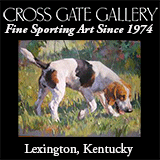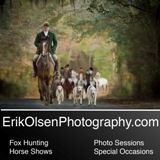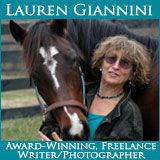Ask the Experts
Is the Ex-Member Entitled to Wear Colors?


Members of Foxhunting Life's Panel of Experts respond to a reader's question. (Clockwise from the top: Masters and huntsmen Marion Thorne, Hugh Robards, Jerry Miller, and Marty Wood.)
A reader asks, “If a member who has quit the club returns to cap, is it appropriate for he or she to wear the colors of that club?”
A good question—simple and practical—yet I couldn’t think of any published rule of attire that addressed the subject.
Can My Foxhound’s Aggression Be Curbed?
 Cathy's seven-year-old pet "mostly-foxhound"
Cathy's seven-year-old pet "mostly-foxhound"
Five-and-a-half years ago, Cathy Eising asked our experts how she could steady her two-year-old pet “mostly-foxhound” on deer and other riot, so she could walk him in the woods off lead. She evidently achieved some success, since she has contacted us with another challenging question. The foxhound is now a seven-year-old.
Cathy asks, “How can I prevent his aggression towards other dogs who are invited into our house by me with their owners? I would like to be able to have friends bring their dogs when visiting and not have fights.”
How the Huntsman Draws for Coyote
 The Genesee Valley hunting country is blessed with both red fox and coyote which have coexisted for thirty-five years. So to say that I would draw specifically for coyote on any given day would be impossible. However, there are areas in which coyote are more likely to be in my country. If am drawing one of those areas, I am very mindful of the wind.
The Genesee Valley hunting country is blessed with both red fox and coyote which have coexisted for thirty-five years. So to say that I would draw specifically for coyote on any given day would be impossible. However, there are areas in which coyote are more likely to be in my country. If am drawing one of those areas, I am very mindful of the wind.
With a coyote it is much more important to draw upwind. He will get up and go much sooner than a fox will. To have the best chance of being close behind him, it is better to draw upwind so he does not wind us and bolt. I would enter the covert quietly, encouraging hounds to concentrate and draw fairly widely.
How the Huntsman Draws Covert
The author explains how a huntsman deploys hounds when drawing covert for a fox, and the considerations that dictate his tactics. Drawing is what the huntsman does when seeking a fox, not to be confused with casting for the fox when hounds are at fault.
Hugh Robards and the foxhounds of the Middleburg Hunt / by Middleburg Photo
On leaving the meet, you might want to keep close to the Field Master so you are in a good position to observe what is going on at the first draw. The whippers-in and other helpers have gone to various point of the covert to view the fox away. Notice on approaching the covert, not one hound leaves the huntsman until he tells them to leu in, at which time hounds enter the covert and begin searching for the scent of a fox. The huntsman wants all hounds in covert when a fox is found so they will all be there to apply pressure, push it out, and be together on the line when it goes away.
If it is a large covert, the huntsman will draw it into the wind, thereby giving the pack every opportunity to wind and rouse their fox. He will also ride into the covert, cheering and encouraging his hounds: “Lieu try, try in there, leu wind ’im, push ’im up old dogs.” That may be what it looks like in print, but most huntsmen make guttural noises that few people can understand!
How Close Should the Field Be to the Huntsman?
Hugh Robards and hounds
A reader writes, “We were discussing the proper distance a field of foxhunters should keep between itself and the huntsman. Is there a rule of thumb that can be applied generally? We thought one simple rule might be to keep the same pace and a reasonably constant distance.... so the huntsman would always know roughly where his field is. But would love to hear what the experts say.”
Here is a question for which there can be no simple rule appropriate for all hunting situations. There are too many factors that modify the “appropriate” distance, even during the course of a single hunt.
We asked huntsman Hugh Robards, just retired after a fifty-five-year professional career in England, Ireland, and America, for his opinion. For twenty-seven seasons, Hugh hunted hounds for Lord Daresbury, MFH, at the County Limerick, showing world-class sport to members and foxhunting visitors from all over the world. Even before becoming a huntsman, Hugh whipped-in to some of the most illustrious British huntsmen of the twentieth century, including Captain Ronnie Wallace at the Heythrop and Brian Gupwell, later to become huntsman for the Duke of Beaufort. Hugh writes:
How to Deer-Proof Hounds In a Wooded Country
 Are hounds right? / Douglas Lees photoAn experienced foxhunter has become Master of a pack of foxhounds and recognizes that he has a deer problem. His hunting country is thickly wooded and accessible via trails. His staff is composed of an experienced amateur huntsman and honorary whippers-in. He whips-in himself, and has experienced first-hand the problems posed by the very nature of the country.
Are hounds right? / Douglas Lees photoAn experienced foxhunter has become Master of a pack of foxhounds and recognizes that he has a deer problem. His hunting country is thickly wooded and accessible via trails. His staff is composed of an experienced amateur huntsman and honorary whippers-in. He whips-in himself, and has experienced first-hand the problems posed by the very nature of the country.
 Or are they wrong? / Douglas Lees photoThere are no discreet coverts to draw that can be surrounded by staff to stop hounds if a deer goes out. In the event of riot, staff is unable to gallop through the thick woods to get ahead of hounds and rate them. Or to even see which hound led the miscreants astray. He understands that he must first teach puppies what the proper quarry is, but he has no access to fox pens to even help him establish good habits from the start.
Or are they wrong? / Douglas Lees photoThere are no discreet coverts to draw that can be surrounded by staff to stop hounds if a deer goes out. In the event of riot, staff is unable to gallop through the thick woods to get ahead of hounds and rate them. Or to even see which hound led the miscreants astray. He understands that he must first teach puppies what the proper quarry is, but he has no access to fox pens to even help him establish good habits from the start.
Thinking outside the box, he came up with the idea of using commercially available deer scent and fox scent as a tool to train hounds.
How to Deer-Proof Hounds In a Wooded Country
 Are hounds right? / Douglas Lees photoWith a new season approaching, and huntsman and staff seriously exercising hounds with the young entry, we thought this article on deer-proofing would be worth republishing.
Are hounds right? / Douglas Lees photoWith a new season approaching, and huntsman and staff seriously exercising hounds with the young entry, we thought this article on deer-proofing would be worth republishing.
An experienced foxhunter, recently appointed Master of a pack of foxhounds, recognizes that he has a deer problem. His hunting country is thickly wooded and accessible via trails. His staff is composed of an experienced amateur huntsman and honorary whippers-in. He whips-in himself, and has experienced first-hand the problems posed by the very nature of the country.
 Or are they wrong? / Douglas Lees photoThere are no discreet coverts to draw that can be surrounded by staff to stop hounds if a deer goes out. In the event of riot, staff is unable to gallop through the thick woods to get ahead of hounds and rate them. Or to even see which hound led the miscreants astray. He understands that he must first teach puppies what the proper quarry is, but he has no access to fox pens to even help him establish good habits from the start.
Or are they wrong? / Douglas Lees photoThere are no discreet coverts to draw that can be surrounded by staff to stop hounds if a deer goes out. In the event of riot, staff is unable to gallop through the thick woods to get ahead of hounds and rate them. Or to even see which hound led the miscreants astray. He understands that he must first teach puppies what the proper quarry is, but he has no access to fox pens to even help him establish good habits from the start.
Thinking outside the box, he came up with the idea of using commercially available deer scent and fox scent as a tool to train hounds.
When Foxhounds Hunt Both Fox and Coyote
Betsy Smith in Virginia's Old Dominion Hunt country / Emma Rowe photoFoxhunting remained pure in much of rural Virginia even as the coyote population was increasing up and down the eastern coastal states. Why much of Virginia’s hunting country was ignored by coyotes is a question for another time, but there’s no doubt that canis latrans has discovered its earlier mistake and, for the last several years, has made substantial property acquisitions in the Old Dominion.
Virginia hunts are handling the situation in various ways—some considering coyote as riot, some adding the coyote to its list of bona fide quarry. For hunts in the latter category, with staff still relatively inexperienced in hunting the coyote, new questions arise for their hound breeding programs.
Betsy Smith asks whether a hound’s nose for coyote scenting should be any different than a hound’s nose for fox scenting. For a pack that hunts both coyote and fox, are there any breeding considerations when it comes to nose?
As a followup question, Betsy asks if there are other more important hound attributes than nose to consider and breed for.
We went to our Panel of Experts and asked two experienced huntsmen, C. Martin Wood, MFH, Live Oak Hounds (FL) and Marion Thorne, MFH, Genesee Valley Hunt (NY), to answer Betsy’s questions for the benefit of their less coyote-savvy friends in Virginia. Although Marty hunts in Florida, and Marion hunts in New York state, it’s uncanny how similarly they feel about what they need in their packs.
A Question of Attire
Brenda Simmons, ex-MFH, at Glenmore Hunt Opening Meet, 2014Brenda Simmons is an ex-Master of the Glenmore Hunt (VA). While an active Master, Brenda, who also whipped-in at the time, wore a scarlet coat.
Brenda asks, “Being an ex-MFH, is it still correct to wear my scarlet coat even though I am a lady?”
When visiting other hunts for joint meets, Brenda tells us that she wears a black hunt coat with Glenmore buttons, colors on the collar, and black boots with patent leather tops, even though Glenmore members may have been invited to wear their colors. When capping at other hunts—no joint meet—Brenda wears a plain black hunt coat, no colors, and plain black boots.
At Glenmore, however, she continues to wear her scarlet coat and wonders if she is correct in doing so. We asked two members of our Panel of Experts for their opinions, and your editor weighs in as well!
Thoughts on Mounted Trophies
These mounted trophies revive memorable hunting adventures in Ireland, England, and Virginia.Mounted game trophies are often seen in hunters’ homes as reminders of adventures worth remembering and fallen game worthy of respect. Also, as in the case of a pair of canvasback ducks shot years ago by my wife and soaring in graceful flight on one wall of our den, trophies may be mounted simply as permanent visions of the beauty of the natural world—one's own museum of natural history—surpassing anything wrought by the artist and cast in cold bronze.
Mounted trophies are also to be found at estate auctions and antique shops. It is the latter category that prompts this query from Foxhunting Life reader Bill Getchell:
“Is there a consensus,” asks Bill, “regarding the display of mounted trophies? Strict constructionists say you should do so only for game that you hunted. Others leave it wide open, maintaining it shows support for the sport and saves the trophy from the trash heap.”
With the caveat that are no right or wrong answers to this question, only personal opinions, here are two thoughtful yet differing views from two experienced and respected sportsmen on FHL’s Panel of Experts: Nigel Peel, MFH and huntsman of the North Cotswold Foxhounds (UK) and Hugh Robards, ex-MFH and currently huntsman of the Middleburg Hunt (VA):

















